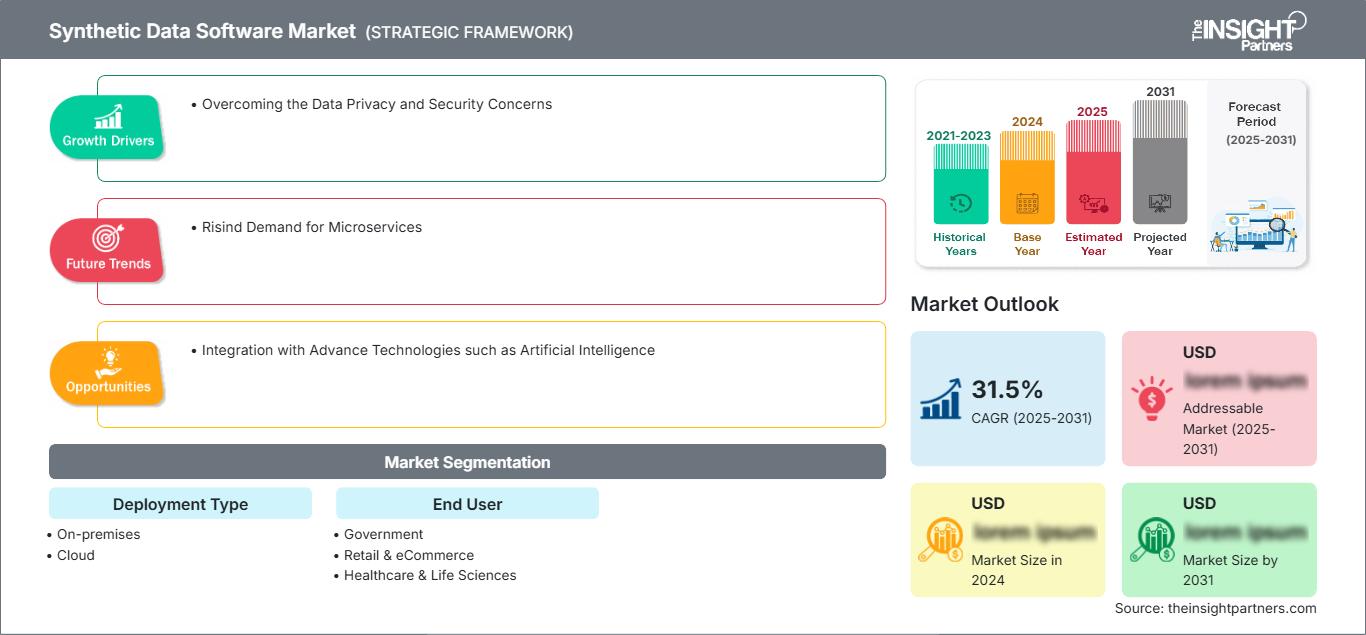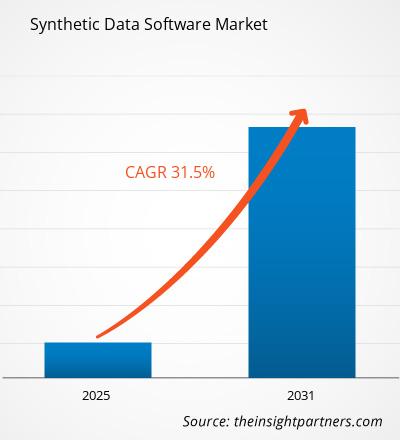Der Markt für synthetische Datensoftware wird zwischen 2023 und 2031 voraussichtlich eine durchschnittliche jährliche Wachstumsrate (CAGR) von 31,5 % verzeichnen. Die Integration mit fortschrittlichen Technologien wie künstlicher Intelligenz wird voraussichtlich ein wichtiger Markttrend bleiben.
Marktanalyse für synthetische Datensoftware
- Der Markt wird in den kommenden Jahren voraussichtlich ein erhebliches Wachstum verzeichnen. Dieses Wachstum ist auf Gründe wie zunehmende Datenschutzbedenken, Cybersicherheitsbedrohungen, personalisierte und flexible Daten sowie den Zugriff auf Echtzeitdaten zurückzuführen.
- Zu den wichtigsten Markttrends gehören technologische Innovationen und die Digitalisierung. Indem der Markt für synthetische Datensoftware diesen Trends folgt und die Chancen nutzt, kann er im Laufe der Zeit stetig wachsen.
Marktüberblick über synthetische Datensoftware
- Synthetische Daten sind ein Datentyp, der künstlich generiert wird, aber Eigenschaften von traditionell manuell generierten Daten besitzt. Synthetische Datensoftware ist ein digitales Tool zur Generierung synthetischer Daten.
- Datenschutz, Zugriff auf Echtzeitdaten, reduzierte Kosten, effizientere und verbesserte Arbeitsabläufe sowie schnellere Entwicklung sind einige der Vorteile synthetischer Datensoftware. Technologische Fortschritte wie maschinelles Lernen und künstliche Intelligenz bieten dem Markt für synthetische Datensoftware spannende Chancen.
Passen Sie diesen Bericht Ihren Anforderungen an
Sie erhalten kostenlos Anpassungen an jedem Bericht, einschließlich Teilen dieses Berichts oder einer Analyse auf Länderebene, eines Excel-Datenpakets sowie tolle Angebote und Rabatte für Start-ups und Universitäten.
Markt für synthetische Datensoftware: Strategische Einblicke

- Holen Sie sich die wichtigsten Markttrends aus diesem Bericht.Dieses KOSTENLOSE Beispiel umfasst Datenanalysen, die von Markttrends bis hin zu Schätzungen und Prognosen reichen.
Sie erhalten kostenlos Anpassungen an jedem Bericht, einschließlich Teilen dieses Berichts oder einer Analyse auf Länderebene, eines Excel-Datenpakets sowie tolle Angebote und Rabatte für Start-ups und Universitäten.
Markt für synthetische Datensoftware: Strategische Einblicke

- Holen Sie sich die wichtigsten Markttrends aus diesem Bericht.Dieses KOSTENLOSE Beispiel umfasst Datenanalysen, die von Markttrends bis hin zu Schätzungen und Prognosen reichen.
Markttreiber und -chancen für synthetische Datensoftware
Überwindung von Datenschutz- und Sicherheitsbedenken
- Schwierigkeiten beim Zugriff auf reale Daten aufgrund strenger Vorschriften verschiedener Organisationen und Gesetze wie dem California Consumer Privacy Act (CCPA), der Datenschutz-Grundverordnung (DSGVO) und anderen. Die steigende Nachfrage nach Datenschutz hat Organisationen und Unternehmen dazu veranlasst, ihre Daten mit äußerster Wachsamkeit zu behandeln.
- Synthetische Datensoftware ermöglicht es Organisationen, authentische, reale Daten zu generieren und gleichzeitig die Privatsphäre des Unternehmens zu wahren und die geltenden Regeln und Vorschriften einzuhalten.
Integration mit fortschrittlichen Technologien wie künstlicher Intelligenz
- Technologien wie KI helfen dabei, authentischere, genauere und realere Daten zu generieren. KI rationalisiert den Arbeitsablauf, indem sie verschiedene manuelle Aufgaben automatisiert und effiziente Daten generiert. Es hilft auch dabei, Daten an die Bedürfnisse bestimmter Branchen anzupassen. KI wird vielversprechende Chancen für den Markt für synthetische Datensoftware schaffen.
Segmentierungsanalyse des Marktberichts für synthetische Datensoftware
Schlüsselsegmente, die zur Ableitung der Marktanalyse für synthetische Datensoftware beigetragen haben, sind Bereitstellungstyp und Endbenutzer.
- Basierend auf dem Bereitstellungstyp ist der Markt in On-Premises und Cloud unterteilt. Das On-Premises-Segment hatte im Jahr 2023 einen bedeutenden Marktanteil.
- Basierend auf den Endbenutzern ist der Markt in Regierung, Einzelhandel und E-Commerce, Gesundheitswesen und Biowissenschaften, BFSI, Transport und Logistik, Telekommunikation und IT, Fertigung und andere segmentiert. Der Regierungsbereich hielt im Jahr 2023 einen bedeutenden Marktanteil.
Marktanteilsanalyse für synthetische Datensoftware nach geografischer Lage
Der geografische Umfang des Marktberichts für synthetische Datensoftware ist hauptsächlich in fünf Regionen unterteilt: Nordamerika, Asien-Pazifik, Europa, Naher Osten und Afrika sowie Süd- und Mittelamerika.
Der Anstieg der Nutzung synthetischer Datengenerierung in BFSI, Einzelhandel, Gesundheitswesen und anderen Sektoren zur Verbesserung der Geschäftsabläufe und der Kundenzufriedenheit dürfte profitable Wachstumsaussichten für den Markt für synthetische Datengenerierung in Nordamerika schaffen. Der Asien-Pazifik-Raum wird in den kommenden Jahren voraussichtlich das stärkste Wachstum verzeichnen. Dieses Wachstum ist auf die zunehmende Integration fortschrittlicher Technologien wie KI/ML und die zunehmende Nutzung cloudbasierter Dienste zurückzuführen, die das Wachstum des Marktes für synthetische Datengenerierung in dieser geografischen Region vorantreiben.
Markt für synthetische Datensoftware
Die Analysten von The Insight Partners haben die regionalen Trends und Faktoren, die den Markt für synthetische Datensoftware im Prognosezeitraum beeinflussen, ausführlich erläutert. In diesem Abschnitt werden auch die Marktsegmente und die geografische Lage in Nordamerika, Europa, dem asiatisch-pazifischen Raum, dem Nahen Osten und Afrika sowie Süd- und Mittelamerika erörtert.Umfang des Marktberichts über synthetische Datensoftware
| Berichtsattribut | Einzelheiten |
|---|---|
| Marktgröße in 2024 | US$ XX million |
| Marktgröße nach 2031 | US$ XX Billion |
| Globale CAGR (2025 - 2031) | 31.5% |
| Historische Daten | 2021-2023 |
| Prognosezeitraum | 2025-2031 |
| Abgedeckte Segmente |
By Bereitstellungstyp
|
| Abgedeckte Regionen und Länder | Nordamerika
|
| Marktführer und wichtige Unternehmensprofile |
|
Dichte der Marktteilnehmer für synthetische Datensoftware: Verständnis ihrer Auswirkungen auf die Geschäftsdynamik
Der Markt für synthetische Datensoftware wächst rasant. Dies wird durch die steigende Endnutzernachfrage aufgrund veränderter Verbraucherpräferenzen, technologischer Fortschritte und eines stärkeren Bewusstseins für die Produktvorteile vorangetrieben. Mit der steigenden Nachfrage erweitern Unternehmen ihr Angebot, entwickeln Innovationen, um den Bedürfnissen der Verbraucher gerecht zu werden, und nutzen neue Trends, was das Marktwachstum weiter ankurbelt.

- Holen Sie sich die Markt für synthetische Datensoftware Übersicht der wichtigsten Akteure
Neuigkeiten und aktuelle Entwicklungen zum Markt für synthetische Datensoftware
Der Markt für synthetische Datensoftware wird durch die Erhebung qualitativer und quantitativer Daten aus Primär- und Sekundärforschung bewertet, die wichtige Unternehmenspublikationen, Verbandsdaten und Datenbanken umfasst. Einige der Entwicklungen auf dem Markt für synthetische Datensoftware sind nachfolgend aufgeführt:
- Anonos, Anbieter der einzigen Technologie, die verwendete Daten mit 100-prozentiger Genauigkeit schützt, gab heute die Übernahme der in Berlin ansässigen Statice GmbH bekannt, einem Anbieter von synthetischer Datensoftware. Mit der Ergänzung der Statice-Lösung, die neue datenschutzkonforme Datenpunkte generiert, welche die statistischen Eigenschaften der Originaldaten widerspiegeln, erweitert Anonos seine Fähigkeit, eine umfassende Plattform bereitzustellen, die schnelle Dateneinblicke für Anwendungsfälle ermöglicht und gleichzeitig den Schutz und die Nutzung der Daten verbessert. Die Statice-Technologie für synthetische Daten wird in die Anonos Data Embassy-Plattform integriert und später in diesem Quartal verfügbar sein. Diese Übernahme folgt auf Anonos kürzliche Ankündigung einer neuen Wachstumsfinanzierung in Höhe von 50 Millionen US-Dollar, abgesichert durch sein Portfolio an geistigem Eigentum, ermöglicht durch Aon (NYSE: AON) und geleitet von GT Investment Partners („Ghost Tree Partners“).
(Quelle: Anonos, Pressemitteilung, November 2022)
Bericht zum Markt für synthetische Datensoftware: Abdeckung und Ergebnisse
Der „Markt für synthetische Datensoftware: Größe und Prognose (2021–2031)“ Der Bericht bietet eine detaillierte Analyse des Marktes und deckt die folgenden Bereiche ab:
- Marktgröße und Prognose für synthetische Datensoftware auf globaler, regionaler und Länderebene für alle abgedeckten wichtigen Marktsegmente
- Markttrends und Marktdynamiken für synthetische Datensoftware wie Treiber, Einschränkungen und wichtige Chancen
- Detaillierte PEST/Porters Five Forces- und SWOT-Analyse
- Marktanalyse für synthetische Datensoftware mit wichtigen Markttrends, globalen und regionalen Rahmenbedingungen, wichtigen Akteuren, Vorschriften und aktuellen Marktentwicklungen
- Branchenlandschafts- und Wettbewerbsanalyse mit Marktkonzentration, Heatmap-Analyse, prominenten Akteuren und aktuellen Entwicklungen für den Markt für synthetische Datensoftware
- Detaillierte Unternehmensprofile
- Historische Analyse (2 Jahre), Basisjahr, Prognose (7 Jahre) mit CAGR
- PEST- und SWOT-Analyse
- Marktgröße Wert/Volumen – Global, Regional, Land
- Branchen- und Wettbewerbslandschaft
- Excel-Datensatz
Aktuelle Berichte
Verwandte Berichte
Erfahrungsberichte
Grund zum Kauf
- Fundierte Entscheidungsfindung
- Marktdynamik verstehen
- Wettbewerbsanalyse
- Kundeneinblicke
- Marktprognosen
- Risikominimierung
- Strategische Planung
- Investitionsbegründung
- Identifizierung neuer Märkte
- Verbesserung von Marketingstrategien
- Steigerung der Betriebseffizienz
- Anpassung an regulatorische Trends




















 Kostenlose Probe anfordern für - Markt für synthetische Datensoftware
Kostenlose Probe anfordern für - Markt für synthetische Datensoftware